I’ve seen a few falcons in my time, and my dad particularly likes to spot them out with his binoculars in hand. Growing up in the UK, we don’t really see many predatory birds, so seeing a falcon swopping and clawing onto its prey mid-air really is an impressive sight to see.
Falcons live in areas all over the planet, and from the small American kestrel to the massive Gyrfalcon, all falcons are a spectacular work of nature, and they deserve to be spoken about.
Evolution and Origin
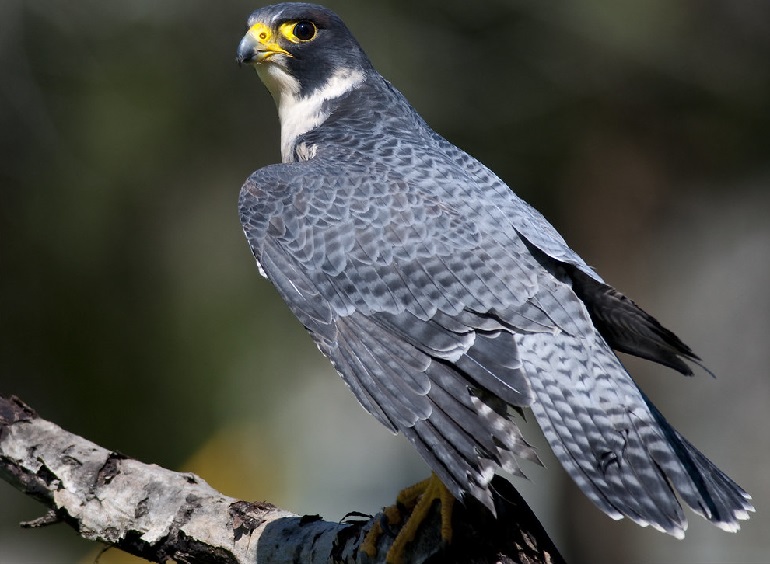
Paleontologists have found falcon fossils dating back less than 10 million years ago, and although that seems like an incredibly long time, other birds of prey date back even further.
By considering the locations where scientists found the fossils, they believe that the falcon originally came from North America, Africa, the Middle East, or Europe; however, pinpointing exactly where the species came from is a much harder task than it seems.
Being a bird of prey, you’d think that falcons were most closely related to other birds of prey, like eagles, ospreys, or hawks, right? Well, actually, the falcon’s nearest relatives are songbirds and parrots, which is strange because these species have very different diets, behaviors, and habitats.
Taxonomy and Etymology
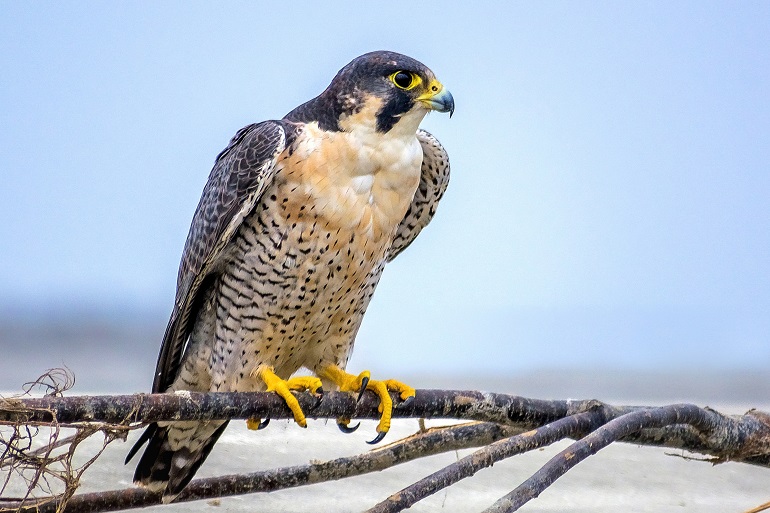
The falcon is a bird of prey that belongs to the genus Falco which a Swedish naturalist first introduced in 1758. Falcons get their genus name, Falco, from the Late Latin words falx and falcis, which simply refer to the bird’s long and curved claws.
Although you may just know falcons as falcons, males actually have their own name, tercel or tiercel, which comes from the Latin word tertius, meaning third.
Male falcons got the names tercel and tiercel because people once believed that of all the eggs a female falcon laid, only one in every three would be a male. However, other people believe that male falcons originally got the name third because they’re one-third smaller than female falcons.
Types of Falcon
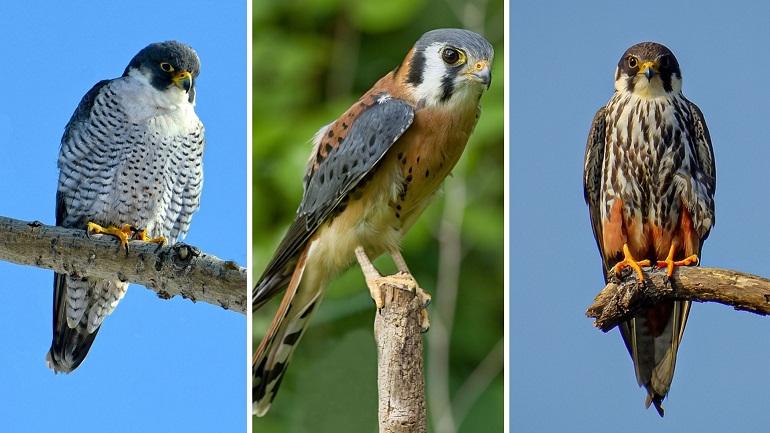
There are roughly 40 subspecies under the falcon species, and although falcons all fall under the same genus title Falco, we can actually separate the subspecies into three or four distinctive groups, the Kestrels, the Hobbies and relatives, the Peregrine falcon and its relatives, and the Hierofalcons.
Kestrels are the smallest falcon subspecies that typically sport brown or gray feathers along their backs and feed on small rodents, insects, and reptiles.
Hobbies are slightly larger than their Kestrel cousins, and you can easily tell them apart as they have dark slate-gray feathers in their plumage and black feathers down the sides of their heads, just below their eyes.
The most well-known falcon group is the Peregrine falcon and its close relatives, which are powerful, fast, and truly impressive.
Falcons in the Peregrine and relatives group have black feathers down the sides of their heads, as well as medium grey and light brown feathers along their backs, and are more patterned than the smaller falcon species.
Falcons in this group feed on mid-sized birds that they snatch straight out of the sky. I think it’s safe to say that you wouldn’t want to be any other bird species living in an area where Peregrine falcons do; I can’t say I would.
The final group, which sometimes falls under the Peregrine group, is the Hierofalcons which have feathers that are red or brown and strong patterns throughout their plumage.
Falcon Species
Some of the most common falcon species include the Peregrine falcon (Falco peregrinus), the Merlin (Falco columbarius), and the American kestrel (Falco sparverius.)
Peregrine Falcon
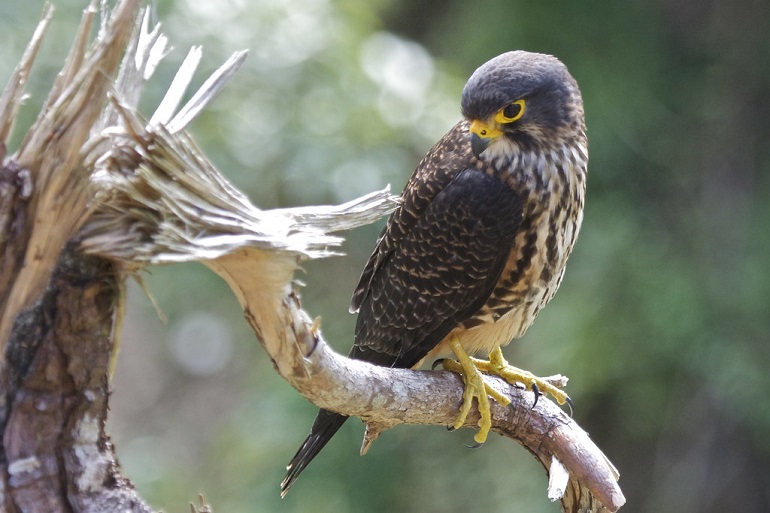
Peregrine falcons are native to northwest America and are known for their incredible speed, agility, and impressive success rates when it comes to hunting prey. Although just after World War 2, Peregrines were nearly wiped out due to DDT pesticides.
They made their way off of the endangered list in 1999, and thanks to being protected under the Migratory Bird Treaty Act, their numbers have continued to rise to make them one of the most widespread species of falcon all over the world.
Merlin
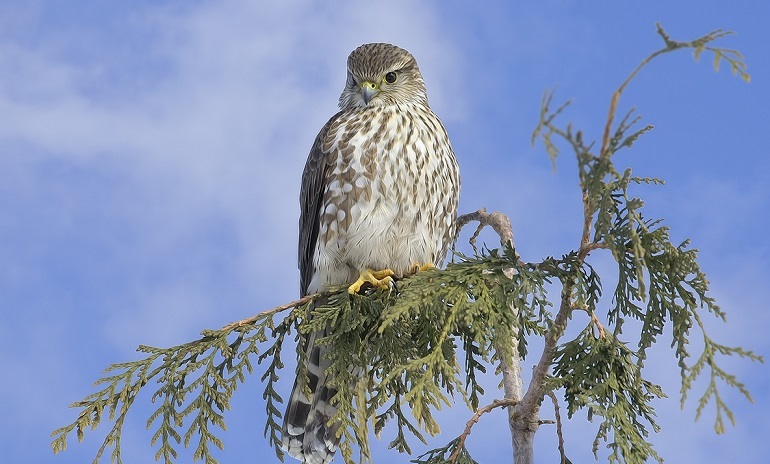
Merlins, or pigeon hawks as you may know them, are a species of falcon that lives in Eurasia, North America, and North Africa. Smaller than the peregrine, Merlins prey on small birds like finches and sparrows.
American Kestrel
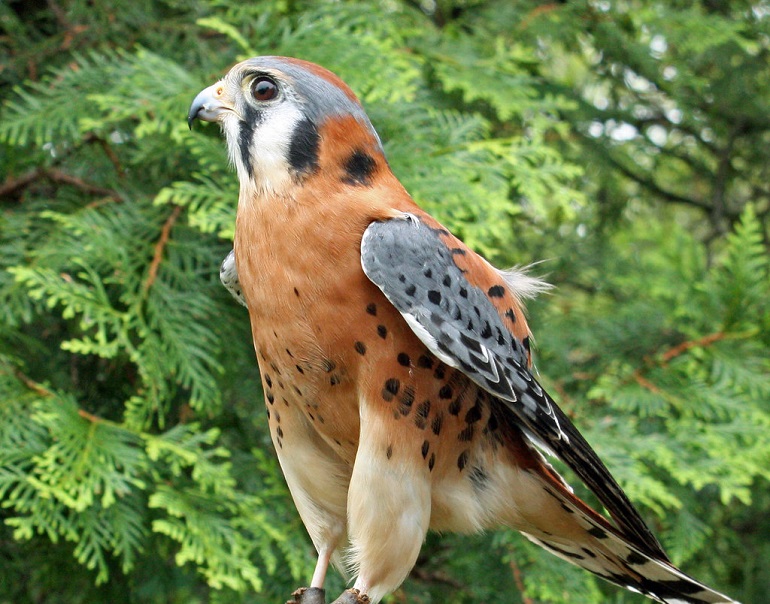
American kestrels, or sparrow hawks, are a popular falcon species throughout central and western Alaska, Canada, North America, Mexico, and the Caribbean, and although they’re the smallest falcon species, they don’t let their size stop them.
Physical Appearance
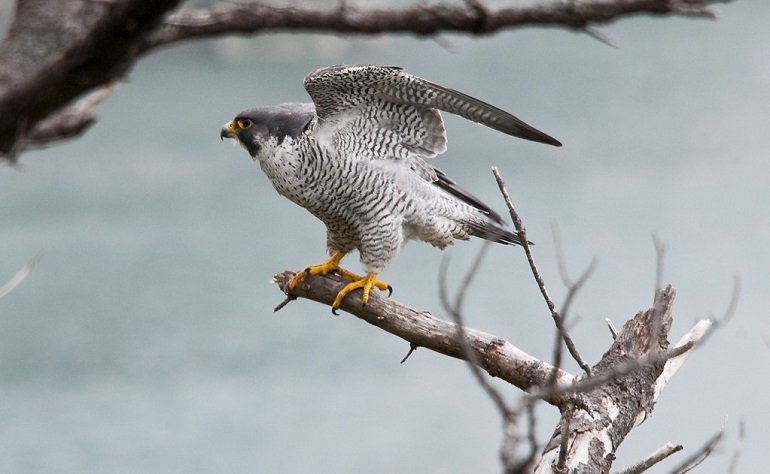
As you now know that there are dozens of falcon subspecies; I’m sure you can imagine that they all range in size, shape, and color. Something they typically have in common, however, is that they have long, pointed wings, sharp curved beaks, and powerful talons, which are claws on their feet that help them catch their prey.
Something unique about the falcon species is that they all have what we call a tomial tooth which is a groove in their beak that helps them kill their prey by breaking the animal’s neck. Pretty ruthless, isn’t it?
How Big Are Falcons?
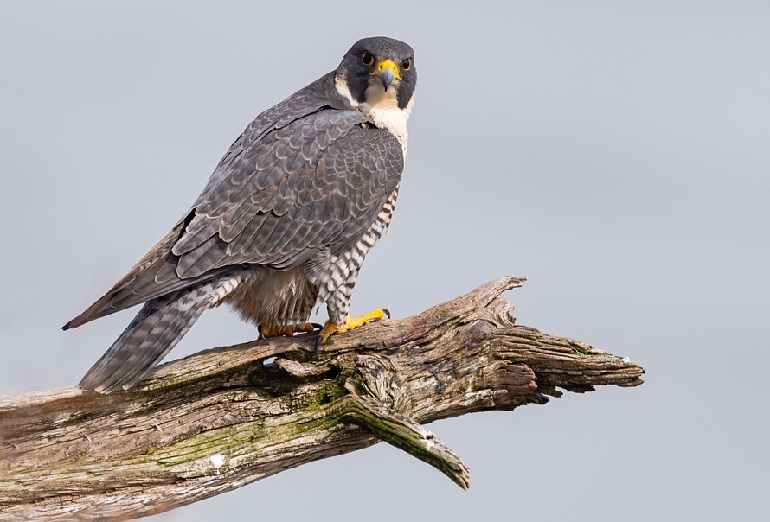
The smallest of the falcon subspecies are the Kestrels, and of all of them, the American kestrel, or the sparrow hawk, is the smallest. American kestrels are roughly 22 centimeters long, with a wingspan of 55 centimeters and an average weight of 117 grams.
Now, American kestrels might seem small but don’t let their size fool you, as these birds are just as mighty as the largest falcon, the Gyrfalcon, and are known to pick fights with hawks and eagles far bigger than them. I think it’s safe to say that picking on someone your own size is a saying American kestrels regularly ignore.
Gyrfalcons, the largest falcon subspecies, are almost three times the size of the American kestrel, with females measuring up to 65 centimeters in length, with a 160-centimeter wingspan, and an average weight of around 1800 grams.
One of the most well-known falcons, the Peregrine falcon (Falco peregrinus), sits in the middle with a body length of 58 centimeters, a wingspan of 120 centimeters, and an average weight of 1200 grams.
Like many other bird of prey species, male falcons are smaller than females, and if you were to put the two together, you would instantly be able to see the difference.
What Color Is a Falcon?
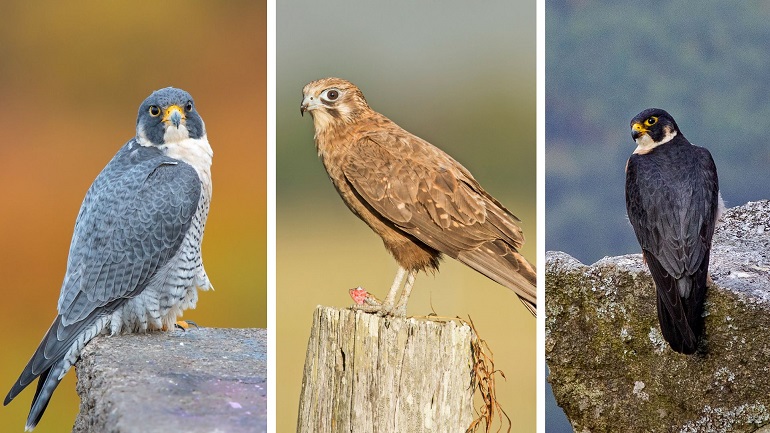
All falcons have different colored feathers, ranging from the Kestrels, which are brown or grey, to the Hobbies, which are slate-gray with black features, and the Peregrine relatives, which are medium gray and light brown with black features.
Many falcon subspecies have patterns throughout their feathers that resemble dots or stripes, and a large percentage of the bigger species have black feathers on their malar, which is the area on the side of their head, behind and below their eyes.
Falcon Facts
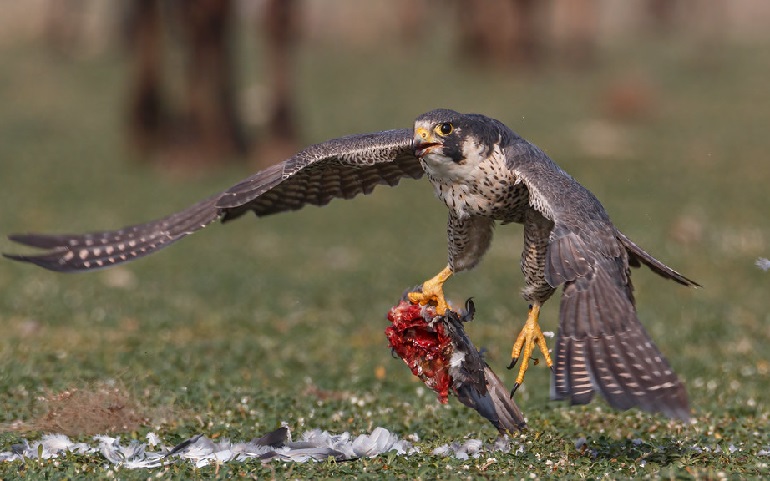
I think falcons are breathtaking animals that deserve more recognition and credit than they are given. Here are some interesting facts about falcons:
- The Peregrine falcon is the fattest of all falcon subspecies, flying at rates of 40 miles per hour while traveling.
But if you thought that was impressive, then you’ll be even more shocked to know that when a Peregrine swoops to catch its prey, it reaches mind-blowing speeds of over 200 miles per hour. Yikes, smaller birds really stand no chance. - Even if you have 20/20 vision, your eyesight is no match for a falcon, as scientists believe that a falcon’s eyesight is eight times better than ours.
- Falconry is the art of training falcons to hunt small animals, and for over 3,500 years, people have dedicated their lives to training falcons.
- Falcons mate for life, but that doesn’t mean they actually like spending quality time with their partners, as the pair only comes together to mate. Romance truly is dead!
- During the war, when mobile phones and emails were thirty years in the future, armies would send carrier pigeons to relay messages. Well, that was until the enemy army hired falcons to hunt down the pigeons and eat them.
- The Ancient Egyptians considered the falcon to be sacred as it represented the god Horus, which you may know as the god with a human body and falcon head.
- We can find Peregrine falcons on all continents except Antarctica because Antarctica is cold, and there aren’t many living things that would actually enjoy living there.
- Peregrine falcons faced extinction after World War 2 as a pesticide DDT killed off many adult birds and weakened the shells of eggs. Luckily for the falcons, the United States banned DDT in 1972, and falcon numbers slowly began to rise.
Hawk and Falcon
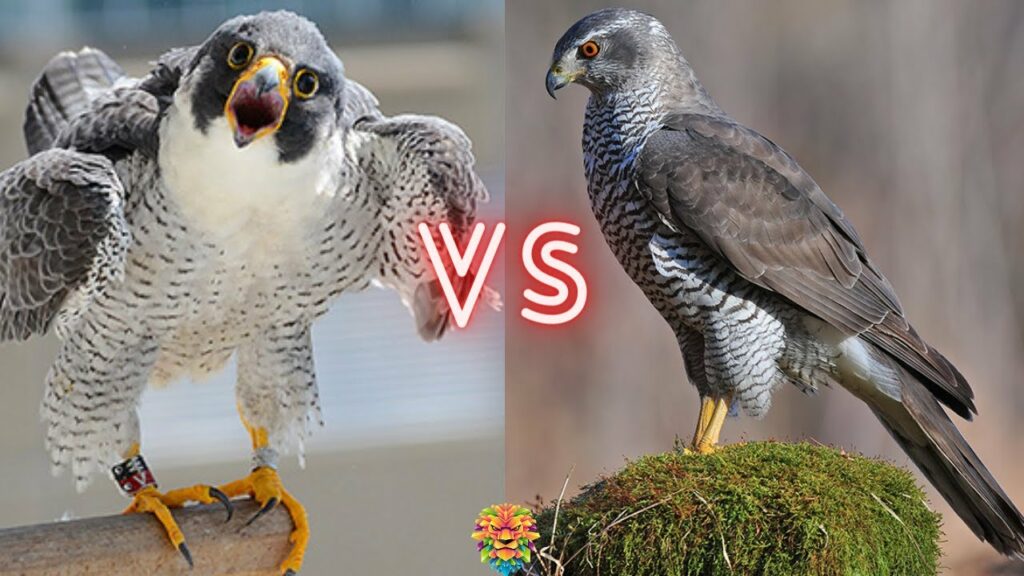
Another raptor species is the hawk, and if you aren’t big on birds, you may have absolutely no idea about the differences between a hawk and a falcon. Lucky for you, I’m here to tell you, and in no time, you’ll be spotting and identifying these birds in the sky.
Hawks are from the family Accipitridae, and like falcons, we can find them all over the world except in Antarctica. One of the biggest differences between hawks and falcons is the way they hunt, as hawks will sit on man-made or natural ledges and will dive down to catch their prey.
Falcons, on the other hand, use their incredible speed and flying skills to swoop down on top and snatch unsuspecting prey right out of the sky. Either way, I would not like to be the prey.
When it comes to their size, falcons may be smaller than hawks, but they have larger wingspans to help them reach fast speeds and turn efficiently when chasing down their prey.
If you do get the incredible opportunity to see a hawk and a falcon side by side, pay close attention to their heads and beaks (but not too close, as their beaks are no joke, and you don’t want to get nipped.)
Falcons have short and rounded heads with a notch in their beak, which ultimately kills their prey. Hawks, on the other hand, have pointier heads, and as they use their long sharp talons to finish off their prey, they don’t need a notch in their beak.
Where To Find Falcons
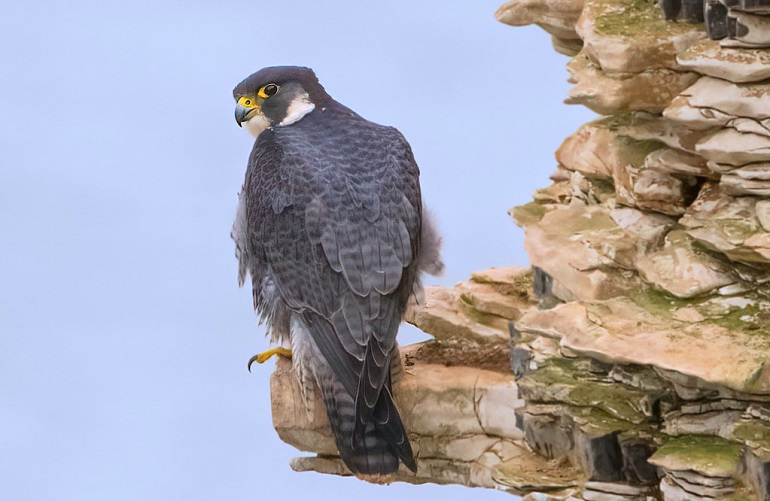
Falcons are one of the world’s most common birds of prey, and regardless of which continent you live on (of course, not in Antarctica, but no one lives permanently in Antarctica), you will be able to see one of the many falcon species.
Living on every continent, falcons have had to adapt their habitats to fit in with the ever-growing human race and concrete jungles we are creating each and every year.
So, not only do falcons live in grasslands, mountains, forests, and wetlands, but they also now live in cities, farms, and parks. One species, the Gyrfalcon, even breeds on the Arctic coast and tundra; they must not mind the cold.
Falcon Behaviour
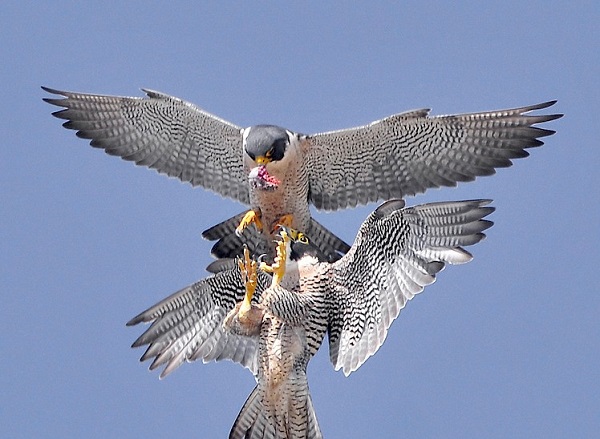
Falcons are hungry animals; can you blame them? And they spend most of their time hunting for prey or resting on perches thinking about their next meal.
It’s common for falcons to hunt from sunrise to sunset, but when the sun finally goes down for the day, they head to their roost sites to sleep and hide from predators.
Nesting
When it comes time for a falcon to nest, it will create what’s known as a nesting site where it lays and incubates its eggs. Nesting sites are usually in locations far away and inaccessible to other predators, like on cliff ledges, in building sites, or in hollowed-out trees.
Migration
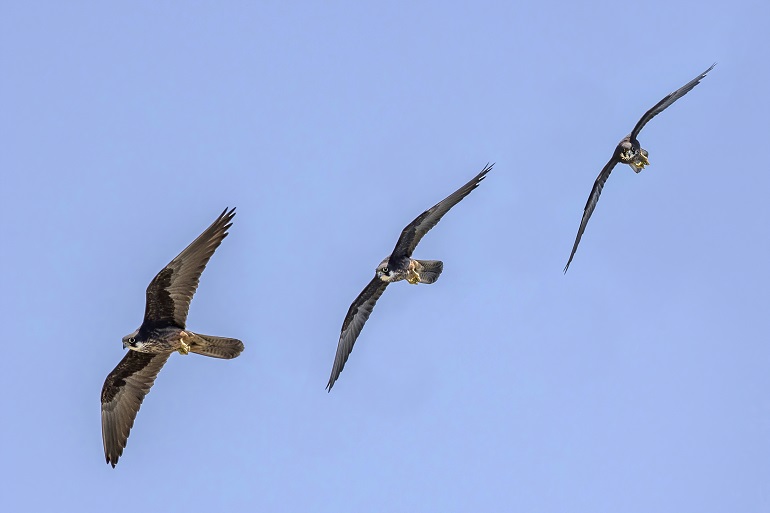
Bird species are known to migrate, and we really can’t blame them because how many people actually enjoy the cold? I know I don’t.
But in saying that, not all falcons migrate. For example, some north American falcon species travel down to central and south America, whereas others stay put in Alaska, the Southwest, the Midwest, and the Northeast.
What Do Falcons Eat?
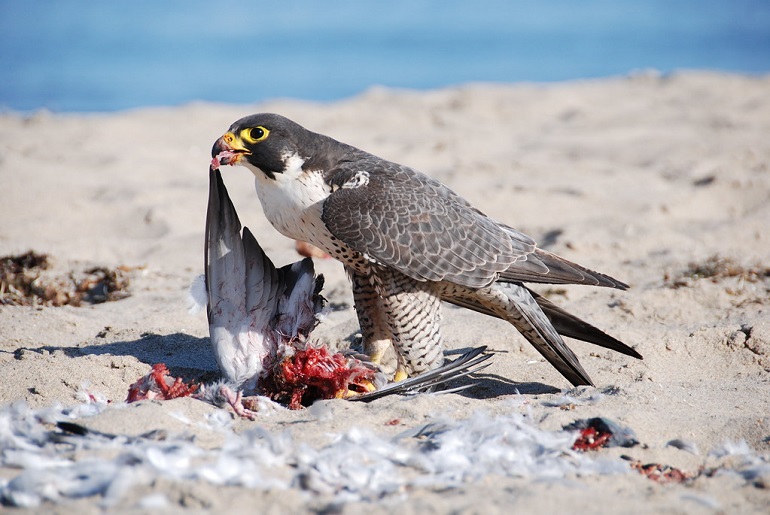
The smaller Kestrel species typically prey on small rodents and reptiles, whereas the larger falcons prey on other birds like ducks, pigeons, and songbirds. Peregrines even go one step further and eat bats along with prey stolen from birds. Peregrines are the bullies of the sky.
Reproduction, Babies, and Lifespan
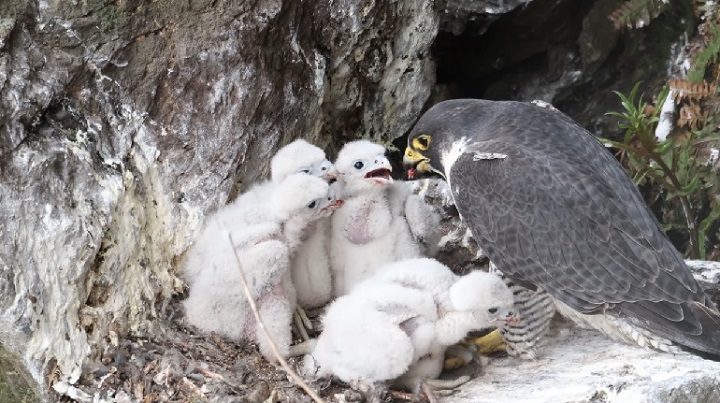
Falcons come together every year to mate, and although most of the time, it simply is just to get the job done, some male falcons will build nests for their partner. It really is the least they can do.
Peregrines, who are always on the go, don’t even take time out for mating; they instead just do it in mid-air, locking talons and doing what you could describe as an acrobatics show before releasing their grip and flying away from one another.
Once the female lays her eggs, she will incubate them in the nest for around a month, then care for her young until they’re old enough to fly away and fend for themselves.
After leaving their mothers, falcon babies will live a relatively long life as although each falcon species is different, for the most part, falcons live 10 to 15 years in the wild, with that number rising to 20 years if the birds are in captivity.
Falcon Population and Conservation Status
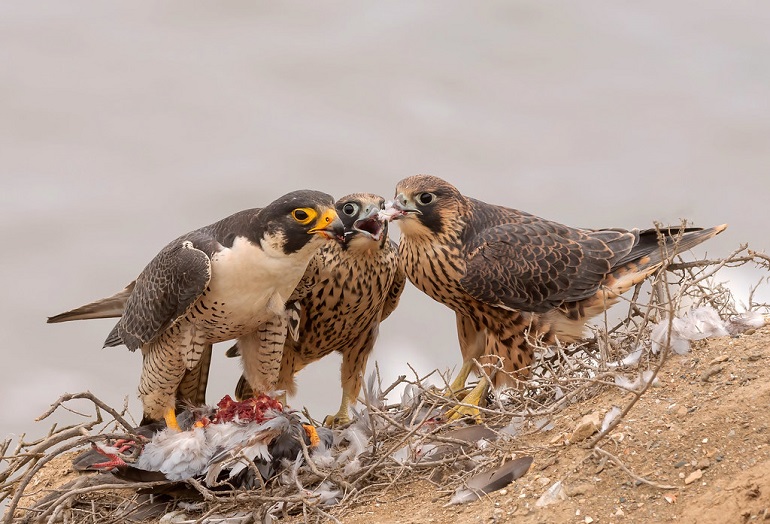
The population and conservation status of falcons varies throughout the species, with some species, like the American kestrel, which has an estimated population of 2.5 million.
Other species, like the Saker falcon, which lives in Eastern Europe, the Middle East, Central Asia, and China, however, has a different story to tell as it is currently endangered with the species population decreasing.
What Eats Falcons?
Although falcons are stealthy predators themselves, there are a few bigger and badder predators out there who don’t mind themselves a falcon entree from time to time.
Humans, owls, eagles, and even wolves are all predators of the falcon, but first, they need to catch them, which considering the Peregrine’s speed, may not be as easy as it seems.
FAQ’s
Is a Falcon a Hawk?
No, a falcon and a hawk are two different species, as hawks belong to the Accipitridae family, and falcons belong to the genus Falco.
Hawks are ultimately larger than falcons with pointier heads, and when it comes to hunting, they will perch on ledges and drive down to their prey, whereas the falcon continuously flies.
Are Falcons Herbivores, Carnivores or Omnivores?
Falcons are carnivores meaning their entire diet is made up of meat from other animals, whether that be rodents, reptiles, or other birds.
What Is a Falcon’s Wingspan?
Falcons have long tapered wings that range in size with the smallest species of falcons’ wings, the American kestrel, measuring 55 cm, the Peregrines measuring 120 cm, and the largest of all falcons; the Gyrfalcon has incredibly long wings that are 160 cm from tip to tip.
I’m 5 foot 4, which equals 162 centimeters, so that really puts into perspective how big the Gyrfalcon is.
How Fast Can a Falcon Fly?
The fastest falcon, the Peregrine, can fly at speeds of over 200 miles per hour when it’s diving down after its prey, and in 1999, the fastest peregrine recorded diving, Frightful, reached 242 miles per hour in Washington, USA. The record even made its way into the Guinness World Records Book. Go Frightful!
Conclusion
Falcons are impressive in more ways than one, from their size and speed to the way they hunt and their ability to be trained, these birds are a force to be reckoned with, and they play a vital part in ecosystems all over the world.


